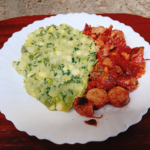Deep within the culinary traditions of the Democratic Republic of the Congo lies a dish that embodies the richness and diversity of Congolese cuisine: Moambe, also known as “Muamba Nsusu.” This traditional Congolese stew is a celebration of flavors, combining succulent meat, vibrant vegetables, and the distinctive taste of palm nuts. Moambe is a beloved dish that represents the cultural heritage and culinary ingenuity of the Congolese people.
The Essence of Moambe
Moambe is a dish deeply rooted in Congolese culture and has become a staple in many households and local gatherings. It is a dish that brings families and communities together, as it is often prepared and enjoyed during festive occasions, such as weddings, birthdays, and holidays.
Ingredients and Flavor Profile
At the heart of Moambe is the use of palm nuts, which lend a unique and rich flavor to the stew. Palm nuts are harvested from the African oil palm tree and are processed to extract the creamy and flavorful palm nut cream used in the dish.
The stew typically features tender and flavorful meat, such as chicken, goat, or beef, as the primary protein component. The meat is cooked until tender and then simmered in a flavorful blend of palm nut cream, onions, garlic, tomatoes, and various spices and herbs.
To enhance the flavor profile, additional vegetables such as spinach, okra, eggplant, or bitterleaf are often incorporated into the stew. These vegetables add depth, color, and texture to the dish, creating a wholesome and well-balanced meal.
Preparation and Cooking Technique
The preparation of Moambe involves several steps to ensure a harmonious blend of flavors. The palm nuts are processed to extract the cream, which forms the base of the stew. The meat is then seasoned and cooked until tender, allowing it to absorb the flavors of the spices and aromatics.
Once the meat is cooked, the palm nut cream, onions, garlic, tomatoes, and spices are added to the pot, creating a rich and aromatic broth. The stew is simmered slowly, allowing the flavors to develop and the ingredients to meld together, resulting in a luscious and flavorful final dish.
Serving and Enjoying Moambe
Moambe is traditionally served with a side of fufu, a staple food made from cassava, plantains, or yams. Fufu is often used as a utensil, with diners tearing off a piece of fufu and using it to scoop up the stew. This interactive and communal way of eating adds to the overall experience of enjoying Moambe.
In some variations, Moambe may also be served with rice or accompanied by other side dishes such as fried plantains, vegetables, or condiments like pili pili (spicy pepper sauce) for an extra kick of heat.
Congolese Moambe is a dish that encapsulates the cultural heritage and culinary richness of the Democratic Republic of the Congo. The combination of succulent meat, vibrant vegetables, and the distinct flavor of palm nuts creates a stew that is deeply comforting, flavorful, and steeped in tradition.
Whether you have the opportunity to taste Moambe in the Democratic Republic of the Congo or explore its flavors in your own kitchen, this iconic Congolese dish promises to transport you to the heart of Congolese cuisine and offer a tantalizing experience of flavors and cultural exploration. So, allow yourself to savor the richness of Moambe and discover the culinary treasures of the Democratic Republic of the Congo.








